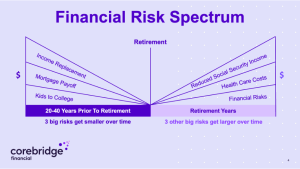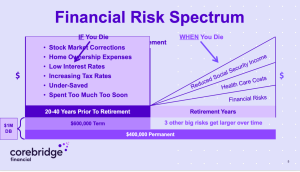Debunking Life Insurance Myths: A Business Owner’s Guide to Coverage
More people don’t obtain life insurance in part because of age-old misconceptions. That was one main takeaway from a 2025 survey by Corebridge Financial: About 40 percent of Americans said that they couldn’t afford life insurance — even though more than half of those respondents estimated the cost to be nearly triple what it actually is.
Another misconception is that life insurance is primarily for the elderly or individuals with children. In reality, most people can benefit from life insurance, especially business owners. Policies like “key person insurance” can protect a business from the financial shock of losing an owner or leader, ensuring its longevity and survival.
The reality is that different life insurance options exist for a wide range of scenarios, and almost anyone can enjoy the protections and peace of mind that come with knowing they have the right policy for their circumstances.
The Shifting Goalposts of Life Insurance
The traditional view of why life insurance matters goes like this: In the event of your sudden death at a pre-retirement age, it protects your loved ones from financial ruin. However, few people consider the need for life insurance in the event that a catastrophe doesn’t strike.
There are financial risks to living a long life, too, which are increasingly common as the average life expectancy of Americans continues to climb. For these reasons and more, savvy clients are obtaining policies that account for both scenarios, using their life insurance portfolio as a vehicle for true financial security.
The Pre-Retirement Risks
Many clients seek out life insurance policies as major life expenses start to appear on the horizon. The average client is someone between the ages of 20 and 50, new to parenthood, and without a bevy of long-term assets (for example, real estate assets, IRAs, and savings accounts). They want to ensure that their family can continue to live a normal life should the breadwinner pass away unexpectedly.
In particular, people consistently cite three financial risks as their top-of-mind concerns when seeking out a policy:
● Mortgage Payments: They want to ensure their family can stay in the same house if they pass away. This is especially true for young families who might still have the bulk of a mortgage to pay down.
● College Costs: Paying for college tuition and the other needs of their children’s young-adult lives (studying abroad, living on an intern’s salary, etc.). People want the peace of mind knowing that their children will still have a quality start to their careers, even if tragedy strikes.
● Income Replacement: Allowing the family to maintain a similar quality of life, including vacations, cars, going out to dinner, and other lifestyle luxuries, all with a single income.
Given these needs, term life insurance has become the go-to option for most consumers, offering a financial backup if a person dies in the short term.
But most people struggle to look further down the road. In reality, your life insurance needs don’t dwindle as you age; the needs merely shift and require different tools, such as permanent life insurance.
The Risks During Retirement
Why would someone need life insurance if they live deep into retirement? Well, imagine a married couple who are in their mid-70s and subsisting mainly on Social Security checks. Their financial risks look vastly different from someone on the verge of starting a family: fewer mortgage payments, no more college tuition looming, and a quieter lifestyle overall.
Still, there can be significant concerns attached to one of the partners passing away in retirement. These include:
● Reduced Security Income: While a widow or widower is entitled to benefits, they won’t receive the full check that their partner received before their death. On average, the government reduces a spouse’s social security benefits by as much as one-half and as little as one-third, lowering the amount of income they have to spend for the rest of their retirement.
● Increased Healthcare Costs: With aging comes higher healthcare costs, regardless of how well you take care of yourself. That’s because healthcare costs are accelerating as a whole (inflation) and the more care you’ll require to maintain your health as you climb in age (utilization). Finding income to pay for these costs can grow more challenging with a partner’s death.
● Navigating Market Volatility: The stock market typically undergoes a major correction once a decade, at least, which can dramatically impact the lives of retirees, who often lean on their investment portfolios for income.
These risks, unlike those that drive people to open life insurance policies earlier in their 30s and 40s, can exponentially grow over time.
The Butterfly Chart
Assessing the intersection of these risks can be best understood through what financial planners often call a “butterfly chart”:

As you can see, the financial risks faced by clients leading up to retirement and those of clients during their retirement years differ. Not only with the kinds of financial concerns they face, but also how those issues evolve over the years. In the decades leading up to retirement, financial risks tend to decrease. Over time, a person should have fewer mortgage payments (as they pay them down) and college costs. But they face the inverse trend during retirement, with the financial risks, like healthcare costs, growing the longer they live.

The butterfly chart clarifies why a combination of term life insurance and permanent life insurance can offer a more holistic form of financial protection.
What is Permanent Life Insurance?
Permanent life insurance, sometimes referred to as whole life insurance or universal life insurance, is a type of policy that provides flexible benefits, some of which can be accessed prior to death.
One essential piece of permanent life insurance is a “cash value” component. As part of the plan, policyholders create a special savings account that accrues value over time. The “cash value” portion is intended to serve as a supplemental, tax-deferred retirement fund. And here’s the difference: Unlike standard death benefits, policyholders don’t have to wait; they can use these savings while they’re still alive.
A permanent life insurance policy can be easily combined with term life insurance in order to prepare for all of the potential scenarios, offering both a guaranteed fallback in the event of a catastrophic loss and savings that are set aside for retirement when you get there.
How Businesses Can Use Permanent Life Insurance
Small- and mid-sized businesses can benefit from permanent life insurance options, such as key person insurance. If a business owner takes out such a policy on one of their employees, and that person ends up passing away, the cash value component of the plan can be used as an important stopgap. The business owner can use those savings to find a quality replacement, to afford temporary workers, or to continue providing healthcare or other benefits to the employee’s family.
Another common strategy is to leverage the cash value component of a plan while the person is still alive to secure a business loan. Then, if that person were to die, the death benefits could be used to pay off that loan.
What’s more, these policies can qualify as tax write-offs for the owners. The payout from permanent life insurance policies is often exempt from year-end income tax. Plus, plans can be customized to include optional riders related to disabilities and critical illnesses, beyond death benefits.
Don’t Let an Unexpected Loss Sink Your Business.
Business owners need to be prepared for every possible scenario. In addition to term life insurance, it’s worth considering the benefits of permanent life insurance.
At AIMCOR EIG, we offer a range of creative solutions to help business owners navigate the unknown. Get in touch with us today to learn more about how our key person insurance could help protect your business against a downturn in the future.
